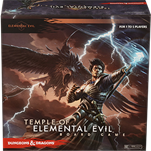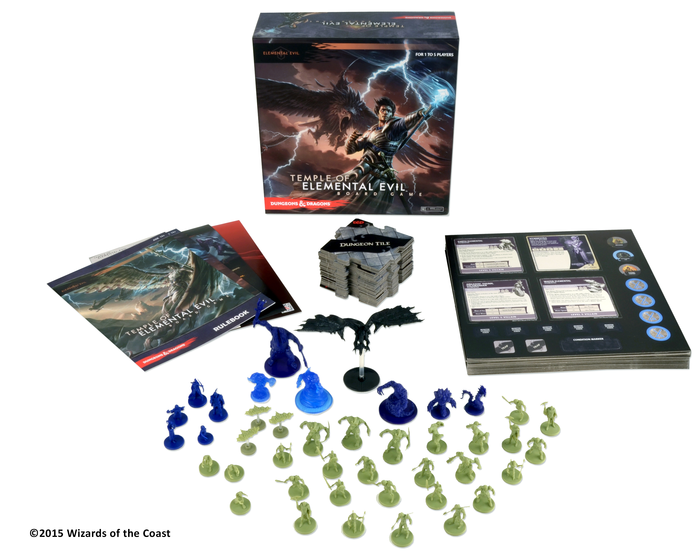 I own a lot of board games – at last count, over 500 of them – but I’m always looking for good new games. Dungeons & Dragons-themed board game are something I always want to try, and yesterday I had my first chance to play the new instalment in the Adventure System: Temple of Elemental Evil.
I own a lot of board games – at last count, over 500 of them – but I’m always looking for good new games. Dungeons & Dragons-themed board game are something I always want to try, and yesterday I had my first chance to play the new instalment in the Adventure System: Temple of Elemental Evil.
The box is heavy, thanks primarily to the large amount of cardboard in it – dungeon tiles, various tokens, and the monster, encounter and treasure cards. The set also has 42 unpainted miniatures in it, most of the sculpts you might recognise from the D&D Icons line of miniatures. Two rulebooks describe the game; one contains the game rules, the other the adventures, 13 in all.
Temple of Elemental Evil is a co-operative board game for 1 to 5 players. You are heroes exploring the dangerous Temple and fighting monsters, avoiding traps, and gathering treasure. The game system itself sets challenges against you: randomly creating the dungeon layout, controlling monster actions and rewarding treasure. Each type of monster behaves differently, thanks to a list of instructions on its card – a form of programmed AI. Not that monsters are that intelligent, but there are differences in how they act.
The game is relatively simple, especially compared to games like Imperial Assault and Descent: Journeys in the Dark. As a result, it feels like a much more casual game. Playing Imperial Assault is intense. Temple of Elemental Evil gives you great tension and adventure, but you’re far less likely to miss something that will come back to bite you later. As a result, I’d be far happier playing Temple of Elemental Evil with younger children than I would Descent or Imperial Assault. It’s still not “simple” – there are plenty of interesting decisions. It just doesn’t require the same attention to detail.
The major change to the game from the previous incarnations (Castle Ravenloft, Wrath of Ashardalon and The Legend of Drizzt) is the assumption of campaign play: the game works best when you play through all thirteen scenarios in order. A few rules have been tweaked to make this work better. Characters are able to purchase additional upgrades between adventures so that they can become more effective, while additional cards are added to the encounter, monster and treasure decks to make games more challenging as the campaign progresses.
A new challenge – traps – are included in the game. Instead of every new tile containing a monster, many tiles contain trapped squares onto which small face-down markers are placed showing how much damage the trap does. Characters can attempt to disarm them, or just move onto them and hope it’s a dud or does minimal damage. When short of time and needing to press onwards, they provide for interesting decision points. A few tiles contain two monsters instead; it’s nice to see how the system’s mechanics continue to evolve.
The game punishes you for staying still. Although new monsters won’t appear if you don’t explore each turn, encounter cards give the game time pressure.
The primary problems that people had with previous versions of the system still apply: in most cases, monsters will get to attack you before you can deal with them, and the encounter clock is punishing.
We played through the first mission yesterday. Our characters woke up trapped in the depths of the Temple of Elemental Evil, and had to make their escape. It was tough, but we played well and were able to escape before we were killed by the cultists.
Future missions include a few set in the town of Red Larch – a name familiar to anyone playing through Princes of the Apocalypse. I note a number of ally cards and tokens – it will be interesting to see how they play!
The components of the game are great, with the dungeon tiles, in particular, being very sturdy and of good quality.
Overall, I’m quite happy with how the game looks. At some point after I’ve had a proper chance to put the game through its paces I’ll do a more in-depth review. For the time being, Temple of Elemental Evil is a good game that works well for people who just want to have fun playing rather than agonizing over every little decision. It gives you a lot of the feel of D&D without the need for a DM.


I picked this one up for the tiles and minis, now I might actually have to read the rulebook, heh.
Thank Merric. I have the other games, but not sure if I want to get this one. Unofficial variants are already out for campaign play. I’m curious if it differs enough for the others to be worth it. How are the city tiles?
The town is fairly basic – it sets up in one configuration. I’ll try to post pictures soon of a game. The major tweak to the game is how it handles traps and can have 0-2 monsters appearing on tiles; very much a fan of that aspect.
Interesting, so the trap mechanic is different from before in that now they can appear on a tile instead of a monster where before they came from encounter cards? Also varying amounts of monsters is good but I already use a variant using the monster tokens for that.
I am enjoying the game so far. Only on Adventure 4 but everyone in our group keeps trying to find time to play the next adventure. We like how each adventure is building upon the previous adventure.
I’m normally not a fan of board game RPGs because they tend to leave me (and most of the players in my group) wishing we had just played an RPG instead. Do you think this might be meaty enough that it ends up scratching that itch, and not leave us wanting for more?
Probably not meaty enough; but, on the other hand, I’m someone who plays really complicated games like Advanced Squad Leader, so you may find otherwise! 🙂
Game is nice, i think some rules need a touching still. What more dissapointed me was the miniatures quality, Poor enough so trying to paint inst worth, axes, torches… they bend pretty easily, up to the point of fearing they break.